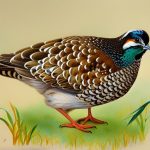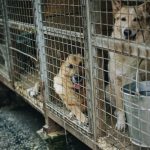Breeding pens are essential for the successful propagation of bobwhite quail. These pens provide a controlled environment where breeders can manage the mating, nesting, and hatching processes. By using breeding pens, breeders can ensure the health and safety of the quail, as well as monitor their breeding behavior and egg production. Additionally, breeding pens allow breeders to select the right breeding stock and manage the genetic diversity of their quail population. Without proper breeding pens, the breeding process can become chaotic and unmanageable, leading to decreased productivity and potential health issues for the quail. Therefore, it is crucial for breeders to establish and maintain well-designed breeding pens to support the successful breeding of bobwhite quail.
Breeding pens also play a significant role in conservation efforts for bobwhite quail. By carefully managing the breeding process in controlled environments, breeders can help preserve the genetic diversity of the species and prevent inbreeding. This is particularly important for maintaining healthy and resilient quail populations in captivity and in the wild. Furthermore, breeding pens provide a safe and secure environment for nesting and hatching, which can increase the survival rates of quail chicks. By creating optimal breeding conditions in these pens, breeders can contribute to the overall sustainability and conservation of bobwhite quail populations. In summary, breeding pens are essential for managing the breeding process, preserving genetic diversity, and supporting conservation efforts for bobwhite quail.
Table of Contents
- 1 Setting Up the Ideal Breeding Environment for Bobwhite Quail
- 2 Selecting the Right Breeding Stock for Bobwhite Quail
- 3 Managing Breeding Pens for Bobwhite Quail
- 4 Ensuring Proper Nutrition and Health for Breeding Bobwhite Quail
- 5 Monitoring Breeding Behavior and Egg Production
- 6 Addressing Challenges and Troubleshooting in Breeding Pens for Bobwhite Quail
- 7 FAQs
- 7.1 What are breeding pens for bobwhite quail?
- 7.2 What are the key features of breeding pens for bobwhite quail?
- 7.3 Why are breeding pens important for bobwhite quail breeding?
- 7.4 How should breeding pens for bobwhite quail be set up?
- 7.5 What are the benefits of using breeding pens for bobwhite quail?
Key Takeaways
- Breeding pens are crucial for maintaining a healthy and productive population of Bobwhite quail.
- The ideal breeding environment for Bobwhite quail includes proper space, shelter, and nesting materials.
- Selecting the right breeding stock is essential for maintaining genetic diversity and overall health of the quail population.
- Managing breeding pens involves regular cleaning, monitoring, and providing necessary care for the quail.
- Proper nutrition and health care are vital for ensuring successful breeding and egg production in Bobwhite quail.
Setting Up the Ideal Breeding Environment for Bobwhite Quail
Creating the ideal breeding environment for bobwhite quail is crucial for successful breeding outcomes. When setting up breeding pens, it is important to consider factors such as space, shelter, nesting materials, and environmental conditions. The pens should provide enough space for the quail to move around comfortably and engage in natural behaviors such as mating, nesting, and foraging. Additionally, the pens should be equipped with shelters or hiding spots to provide security and protection for the quail. These shelters can be in the form of brush piles, wooden structures, or artificial covers to mimic natural habitat conditions.
Nesting materials are also essential for creating a suitable breeding environment. Providing appropriate nesting materials such as straw, hay, or grasses can encourage quail to build nests and lay eggs. The availability of nesting materials can also reduce stress and improve the overall well-being of the quail during the breeding process. Furthermore, maintaining optimal environmental conditions within the breeding pens is critical for successful breeding. This includes regulating temperature, humidity, and lighting to mimic natural seasonal changes and promote reproductive behaviors in the quail. By setting up the ideal breeding environment with adequate space, shelter, nesting materials, and environmental conditions, breeders can create a conducive setting for successful bobwhite quail breeding.
Selecting the Right Breeding Stock for Bobwhite Quail
Selecting the right breeding stock is a critical step in establishing a successful breeding program for bobwhite quail. The quality of the breeding stock directly impacts the genetic diversity, health, and productivity of the quail population. When choosing breeding stock, breeders should prioritize traits such as genetic diversity, physical health, reproductive performance, and behavioral characteristics. Genetic diversity is essential for maintaining a robust and resilient quail population, as it reduces the risk of genetic disorders and promotes overall population health. Therefore, breeders should select breeding stock from diverse genetic lineages to ensure a healthy and genetically varied population.
Physical health and reproductive performance are also important factors to consider when selecting breeding stock. Breeders should choose quail that are free from any hereditary or congenital health issues and demonstrate strong reproductive capabilities. This includes assessing factors such as body condition, feather quality, and previous breeding history to identify healthy and fertile individuals for breeding purposes. Additionally, behavioral characteristics such as mating behavior, nesting instincts, and parental care should be evaluated when selecting breeding stock. Quail with desirable behavioral traits are more likely to exhibit natural reproductive behaviors and successfully raise offspring in breeding pens. By carefully selecting the right breeding stock based on genetic diversity, physical health, reproductive performance, and behavioral characteristics, breeders can establish a strong foundation for successful bobwhite quail breeding programs.
Managing Breeding Pens for Bobwhite Quail
Managing breeding pens for bobwhite quail involves various tasks and responsibilities to ensure the well-being and productivity of the quail population. This includes maintaining cleanliness and hygiene within the pens to prevent disease outbreaks and reduce stress on the quail. Regular cleaning of pens, removal of waste materials, and disinfection of nesting areas are essential practices to promote a healthy breeding environment. Additionally, managing breeding pens involves monitoring environmental conditions such as temperature, humidity, and lighting to create optimal conditions for reproductive behaviors and egg production.
Another important aspect of managing breeding pens is providing adequate nutrition and access to clean water for the quail. Proper nutrition is crucial for supporting reproductive health and egg production in bobwhite quail. Breeders should offer a balanced diet that includes high-quality feed, grains, seeds, and supplemental vitamins and minerals to meet the nutritional needs of breeding quail. Access to clean water is also essential for maintaining hydration and supporting overall health in the breeding pens. Furthermore, managing breeding pens involves monitoring the social dynamics and behavior of the quail to ensure harmonious interactions and minimize aggression or stress within the population. By effectively managing breeding pens through cleanliness, environmental control, nutrition, and social dynamics, breeders can support successful bobwhite quail breeding outcomes.
Ensuring Proper Nutrition and Health for Breeding Bobwhite Quail
Ensuring proper nutrition and health is crucial for supporting successful breeding outcomes in bobwhite quail. Breeding quail have specific nutritional requirements that must be met to support reproductive health, egg production, and chick development. Providing a balanced diet that includes high-quality feed, grains, seeds, and supplemental vitamins and minerals is essential for meeting the nutritional needs of breeding quail. Additionally, offering calcium supplements can support strong eggshell formation and prevent calcium deficiencies in laying hens. Breeders should also monitor the body condition of breeding quail to ensure they are receiving adequate nutrition and maintain a healthy weight for optimal reproductive performance.
In addition to nutrition, maintaining overall health is important for successful breeding in bobwhite quail. Breeders should implement regular health checks and preventive measures to minimize the risk of diseases or parasites within the breeding pens. This includes monitoring for signs of illness or distress, administering vaccinations or treatments as needed, and implementing biosecurity measures to prevent disease transmission. Providing a clean and hygienic environment within the breeding pens is also essential for supporting overall health in the quail population. By ensuring proper nutrition and health through balanced diets, supplements, preventive care, and hygiene practices, breeders can support successful breeding outcomes in bobwhite quail.
Monitoring Breeding Behavior and Egg Production

Monitoring breeding behavior and egg production is essential for assessing the reproductive performance of bobwhite quail in breeding pens. Breeders should observe mating behaviors such as courtship displays, vocalizations, and physical interactions between male and female quail to identify successful mating pairs. Monitoring mating behaviors can help breeders assess reproductive compatibility between individuals and track mating success within the population. Additionally, observing nesting behaviors such as nest building, egg laying, and incubation can provide valuable insights into the reproductive activity of the quail.
Tracking egg production is another important aspect of monitoring breeding behavior in bobwhite quail. Breeders should record the number of eggs laid by individual hens, as well as monitor egg quality and fertility rates to assess reproductive performance. This information can help breeders identify productive hens, track seasonal variations in egg production, and make informed decisions about managing breeding stock. By closely monitoring breeding behavior and egg production in bobwhite quail, breeders can gain valuable insights into reproductive activity, assess mating success, and make informed decisions to support successful breeding outcomes.
Addressing Challenges and Troubleshooting in Breeding Pens for Bobwhite Quail
Breeding pens for bobwhite quail may encounter various challenges that require proactive management and troubleshooting by breeders. Common challenges in breeding pens include aggression between individuals, egg infertility or low hatch rates, disease outbreaks, environmental stressors, or reproductive abnormalities. To address these challenges effectively, breeders should implement proactive measures such as providing adequate space and hiding spots to reduce aggression among quail individuals. Additionally, optimizing environmental conditions such as temperature, humidity, and lighting can help minimize stress on the quail population.
Addressing challenges related to egg production may involve assessing factors such as nutrition deficiencies, age-related declines in fertility, or genetic influences on reproductive performance. Breeders should evaluate the diet of breeding quail to ensure they are receiving adequate nutrition to support egg production. Additionally, monitoring fertility rates and conducting fertility tests on eggs can help identify potential issues with reproductive health or genetic influences on fertility within the population.
Disease outbreaks are another common challenge that breeders may encounter in breeding pens for bobwhite quail. Implementing biosecurity measures such as quarantine protocols for new birds or visitors can help prevent disease transmission within the population. Regular health checks and monitoring for signs of illness can also aid in early detection of disease outbreaks and prompt intervention with appropriate treatments or vaccinations.
In summary, addressing challenges and troubleshooting in breeding pens for bobwhite quail requires proactive management strategies such as optimizing space and environmental conditions, evaluating nutrition and fertility factors, implementing biosecurity measures, conducting regular health checks, and intervening promptly to address any issues that arise within the population.
In conclusion, establishing well-designed breeding pens is crucial for supporting successful propagation of bobwhite quail populations. By creating optimal breeding environments with adequate space, shelter, nesting materials, and environmental conditions, breeders can promote natural reproductive behaviors and successful egg production in their quail populations. Selecting the right breeding stock based on genetic diversity, physical health, reproductive performance, and behavioral characteristics is essential for establishing a strong foundation for successful bobwhite quail breeding programs.
Managing breeding pens involves various tasks such as maintaining cleanliness and hygiene within the pens, monitoring environmental conditions such as temperature and humidity levels to create optimal conditions for reproductive behaviors and egg production.
Ensuring proper nutrition through balanced diets, supplements, preventive care measures such as regular health checks are crucial for supporting successful breeding outcomes in bobwhite quail populations.
Monitoring mating behaviors such as courtship displays between male and female quails can help breeders assess reproductive compatibility between individuals.
Addressing challenges related to egg production may involve assessing factors such as nutrition deficiencies or age-related declines in fertility within the population.
In summary addressing challenges related to disease outbreaks may involve implementing biosecurity measures such as quarantine protocols for new birds or visitors within the population.
In conclusion establishing well-designed breeding pens is crucial for supporting successful propagation of bobwhite quail populations by creating optimal environments with adequate space shelter nesting materials environmental conditions selecting right stock managing cleanliness hygiene nutrition monitoring mating behaviors addressing challenges related to egg production disease outbreaks biosecurity measures regular health checks intervening promptly to address any issues that arise within population . By implementing these measures, breeders can ensure the health and productivity of their bobwhite quail populations, ultimately contributing to the conservation and sustainability of this species. Additionally, maintaining detailed records and staying informed about best practices in quail breeding will further support the success of the breeding program. Overall, a well-managed breeding program is essential for the long-term viability of bobwhite quail populations.
If you’re looking to create the ideal breeding pens for bobwhite quail, you might also be interested in learning about the best type of coop for chickens. Check out this informative article on what kind of coop is best for chickens to ensure that your feathered friends have a comfortable and secure living space. Understanding the importance of a suitable coop can help you provide the best environment for your quail breeding operation.
FAQs
What are breeding pens for bobwhite quail?
Breeding pens for bobwhite quail are specially designed enclosures or structures used to house and breed bobwhite quail for the purpose of producing offspring.
What are the key features of breeding pens for bobwhite quail?
Breeding pens for bobwhite quail typically include features such as proper ventilation, nesting areas, perches, and feeding and watering systems to create a suitable environment for breeding and raising quail.
Why are breeding pens important for bobwhite quail breeding?
Breeding pens provide a controlled environment for bobwhite quail to mate, lay eggs, and raise their young, which can help increase the success rate of breeding and ensure the health and safety of the quail and their offspring.
How should breeding pens for bobwhite quail be set up?
Breeding pens for bobwhite quail should be set up in a quiet and secluded area to minimize stress on the birds. The pens should also be designed to allow for easy access for monitoring and maintenance.
What are the benefits of using breeding pens for bobwhite quail?
Using breeding pens can help breeders to efficiently manage and monitor the breeding process, control the breeding environment, and increase the likelihood of successful breeding and hatching of bobwhite quail eggs.
Meet Walter, the feathered-friend fanatic of Florida! Nestled in the sunshine state, Walter struts through life with his feathered companions, clucking his way to happiness. With a coop that’s fancier than a five-star hotel, he’s the Don Juan of the chicken world. When he’s not teaching his hens to do the cha-cha, you’ll find him in a heated debate with his prized rooster, Sir Clucks-a-Lot. Walter’s poultry passion is no yolk; he’s the sunny-side-up guy you never knew you needed in your flock of friends!







